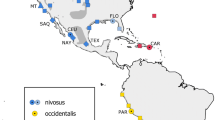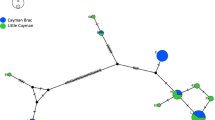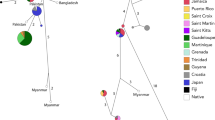Abstract
In order to define evolutionarily significant and management units (ESUs and MUs) among subpopulations of Sumatran (Pongo pygmaeus abelii) and Bornean (P. p. pygmaeus) orangutans we determined their genetic relationships. We analyzed partial sequences of four mitochondrial genes and nine autosomal microsatellite loci of 70 orangutans to test two hypotheses regarding the population structure within Borneo and the genetic distinction between Bornean and Sumatran orangutans. Our data show Bornean orangutans consist of two genetic clusters—the western and eastern clades. Each taxon exhibits relatively distinct mtDNA and nuclear genetic distributions that are likely attributable to genetic drift. These groups, however, do not warrant designations as separate conservation MUs because they demonstrate no demographic independence and only moderate genetic differentiation. Our findings also indicate relatively high levels of overall genetic diversity within Borneo, suggesting that observed habitat fragmentation and erosion during the last three decades had limited influence on genetic variability. Because the mtDNA of Bornean and Sumatran orangutans are not strictly reciprocally monophyletic, we recommend treating these populations as separate MUs and discontinuing inter-island translocation of animals unless absolutely necessary.




Similar content being viewed by others
References
Baker AJ, Daugherty CH, Colbourne R, McLennan JL (1995) Flightless brown kiwi of New Zealand possess extremely subdivided population structure and cryptic species like small mammals. PNAS 92:8254–8258
Bandelt H, Forster P, Röhl A (1999) Median-joining networks for inferring intraspecific phylogenies. Mol Biol Evol 16:37–48
Castelloe J, Templeton AR (1994) Root probabilities for intraspecific gene trees under neutral coalescent theory. Mol Phyl Evol 3:102–113
Collura RV, Stewart C (1995) Insertions and duplications of mtDNA in the nuclear genomes of Old World monkeys and hominoids. Nature 378:485–489
Crandall KA, Templeton AR (1993) Empirical tests of some predictions from coalescent theory with applications to intraspecific phylogeny reconstruction. Genetics 134:959–969
Crandall KA, Bininda-Evans ORP, Mace GM, Wayne RK (2000) Considering evolutionary processes in conservation biology. Trends Ecol Evol 15:290–295
Excoffier L, Smouse P, Quattro J (1992) Analysis of molecular variance inferred from metric distance among DNA haplotypes: application to human mitochondrial DNA restriction data. Genetics 131:479–491
Falush D, Stephens M, Pritchard JK (2003) Inference of population structure using multilocus genotype data: linked loci and correlated allele frequencies. Genetics 164:1567–1587
Felsenstein J (1985) Confidence limits on phylogenies with a molecular clock. Syst Zool, 34:152–161
Felsenstein J (2004) PHYLIP (phylogenetic inference package) version 3.6. Distributed by author. University of Washington, Seattle
Forster P (2004) NETWORK version 4.1.0.6. Distributed by Fluxus Technology.
Fraser DJ, Bernatchez L (2001) Adaptive evolutionary conservation: towards a unified concept for identifying conservation units. Mol Ecol 10:2741–2752
Groves CP, Westwood C, Shea BT (1992) Unfinished business: Mahalanobis and a clockwork orang. J Human Evol 22:327–340
Hanski I, Gilpin M (1991) Metapopulation dynamics: brief history and conceptual domain. Biol J Linn Soc 42:3–16
Hartl DL, Clark AG (1989) Principles of population genetics, 2nd edn. Sinauer, Sunderland
Hedrick PW (1995) Gene flow and genetic restoration: the Florida panther as a case study. Cons Biol 9:996–1007
Janczewski DN (1989) Estimate of genetic distance of orang utan (Pongo pygmaeus) subspecies based on isozyme and two-dimensional gel electrophoresis. PhD thesis, George Mason University
Janczewski DN, Goldman D, O’Brien SJ (1990) Molecular genetic divergence of orang-utan (Pongo pygmaeus) subspecies based on isozyme and two dimensional gel electrophoresis. Heredity 81:375–397
Kanthaswamy S, Smith DG (2002) Population subdivision and gene flow among wild orangutans. Primates 43:315–327
Kanthaswamy S, Bininda-Emonds ORP, Warden C, Viray JL, Smith DG (2001) Use of SSR fragment length homozygotes for orangutan systematics. Primates 42:35–45
Kawamoto Y, Ischak TM, Supriatna J (1984) Genetic variations within and between troops of the crab-eating macaque (Macaca fascicularis) on Sumatra, Java, Bali, Lambok and Sumbawa, Indonesia. Primates 25:131–159
Kimura M, Crow J (1964) The number of alleles that can be maintained in a finite population. Genetics 49:725–738
Kocher TD, Thomas WK, Meyer A, Edwards SV Päabo S, Fillablanca FX, Wilson AC (1989) Dynamics of mitochondrial DNA evolution in animals: Amplification and sequencing with conserved primers. Evolution 86:6196–6200
Lacy RC (1987) Loss of genetic diversity from managed populations: interacting effects of drift, mutation, immigration, selection, and population subdivision. Cons Biol 1:143–158
Lande R, Barrowclough GF (1987) Effective population size, genetic variation and their use in population management. In: Soule ME (ed) Variable populations for conservation. Cambridge University Press, New York pp 87–123
Lynch M (1991) The genetic interpretation of inbreeding depression and outbreeding depression. Evolution 45:622–629
Lyons-Weiler J, Hoelzer GA, Taush RJ (1998) Optimal outgroup analysis. Biol J Linn Soc 64:4933–5011
Melnick DJ, Hoelzer GA (1992) Differences in male and female macaque dispersal lead to contrasting distributions of nuclear and mitochondrial DNA variation. Int J Primatol 13:379–393
Moritz C (1994) Applications defining ‘evolutionarily significant units’ for conservation. Trends Ecol Evol 3:401–412
Moritz C (1995) Use of molecular phylogenies for conservation. In: Harvey PL et al (eds) New uses for new phylogenies. Phil Trans R Soc Lond B 349:113–118
Muir CC, Galdikas BMF, Beckenbach AT (2000) mtDNA sequence diversity of orangutans from the islands of Borneo and Sumatra. J Mol Evol 51:471–480
Nei M (1987) Molecular evolutionary genetics. Columbia University Press, New York
O’Brien SJ, Mayr E (1991) Bureaucratic mischief: recognizing endangered species and subspecies. Science 251:1187–1188
Ohta T, Kimura M (1973) A model of mutation appropriate to estimate the number of electrophoretically detectable alleles in a finite population. Genet Res 22: 201–204
Page RDM (1996) TREEVIEW: an application to display phylogenetic trees on personal computers. Compt Appl Biosci 12:357–358
Pritchard JK, Stephens M, Donnelly P (2000) Inference of population structure using multilocus genotype data. Genetics 155:945–959
Raymond M, Rousset F (1995) GenePop (version 1.2). Population genetics software for exact tests and ecumenicism. Heredity 86:248–249
Schneider S, Roessli D, Excofflier L (2000) ARLEQUIN 2.0: a software for population genetic data analysis. Laboratory of Genetics and Biometry, University of Geneva, Switzerland
Slatkin M (1985) Gene flow in natural populations. Annu Rev Ecol Syst 16:393–430
Slatkin M (1995) A measure of population subdivision based on microsatellite allele frequencies. Genetics 139:457–462
Tamura K, Nei MT (1993) Estimation of the number of nucleotide substitutions in the control region of the mitochondrial DNA in humans and chimpanzees. Mol Biol Evol 10:512–526
Templeton AR (1986) Coadaptation and inbreeding depression. In: Soule ME (ed) Conservation biology: the science of scarcity and diversity. Sinauer, Sunderland, pp 105–116
Templeton AR, Read B (1984) Factor eliminating inbreeding deprivation in a captive herd of Speke’s gazelles. Zoo Biol 3:177–199
Tiedemann R, Hardy O, Vekemans X, Milinkovitch MC (2000) Higher impact of female than male migration on population structure in large mammals. Mol Ecol 9:1159–1163
Toonen RJ, Hughes S (2001) Increased throughput for fragment analysis on an ABI Prizm® 377 automated sequencer using a membrane comb and STRand software. Biotechniques 31:1320–1324
Tosi AJ, Morales JC, Melnick DJ (2000) Comparison of Y chromosome and mtDNA phylogenies leads to unique inferences of macaque evolutionary history. Mol Phyl Evol 17:133–144
Uchida A (1998) Variation in tooth morphology of Pongo pygmaeus. J Human Evol 34:71–79
Vrijenhoek RC (1994) Genetic diversity and fitness in small populations. In: Loeschke V, Tomiuk J, Jaih SK (eds) Conservation genetics. Birkhäuser, Basel, pp 37–53
Waples RS, Gustafson RG, Weitkamp LA, Myers JM, Johnson OW, Busby PJ, Hard JJ, Bryant GJ, Waknitz FW, Neely K, Teel D, Grant WS, Winans GA, Phelps S, Marshall A, Baker BM (2001) Characterizing diversity in salmon from the Pacific Northwest. J Fish Biol 59:1–41
Warren KS, Nijman IJ, Lenstra JA, Swan RA, Heriyanto Den Boer MH (2000) Microsatellite DNA variation in Bornean orang-utans. J Med Primatol 29:57–62
Warren KS, Verschoor EJ, Langenhuijzen S, Heriyanto, Swan RA, Vigilant L, Heeney J (2001) Speciation and intrasubspecific variation of Bornean Orangutans, Pongo pygmaeus pygmaeus. Mol Biol Evol 18:472–480
Weir BS, Cockerham CC (1984) Estimating F-statistics for the analysis of population structure. Evolution 38:1358–1370
Wright S (1977) Evolution and genetics of populations. Chicago University Press, Chicago
Xu X, Arnason U (1996) The mitochondrial DNA molecule of Sumatran orangutan and a molecular proposal for two (Bornean and Sumatran) species of orangutan. J Mol Evol 43:431–437
Yeh FC, Boyle TJB (1997) Population genetic analysis of co-dominant and dominant markers and quantitative traits. Belg J Bot 129:157
Zhi L, Karesh WB, Janczewski DN, Frazier-Taylor H, Sajuthi D, Gombek F, Andau M, Martenson JS, O’Brien SJ (1996) Genomic differentiation among natural populations of oran-utan (Pongo pygmaeus). Curr Biol 6:1326–1336
Acknowledgements
This study was supported by research allocations (awarded to S.K.) from the Sarawak State Government, Malaysia, the California National Primate Research Center and the Veterinary Genetics Laboratory, School of Veterinary Medicine, University of California, Davis, for primate population genetics research. The authors also wish to thank Andrea Von Dollen and Ona Alminas for their technical assistance, and Meagan Sutherland and Clint Pells for their aid in this manuscript. We are grateful to Professor Balbir Singh, a faculty of Medicine and Health Sciences Department, Universiti Malaysia Sarawak for his laboratory space for microsatellite and sequencing analyses and the State Government of Sarawak and Federal Government, Malaysia for permitting the sampling of the Sarawak animals. We thank the following facilities for providing us with samples ex gratia: Stephen J. O’Brien Laboratory, Laboratory of Genomic Diversity, National Cancer Institute at Frederick Cancer Research and Development, Frederick, MD; Audubon Zoo, New Orleans, LA; Birmingham Zoo, Alabama Zoological Society, Birmingham, AL; Cheyenne Mountain Zoo, Colorado Springs, CO; Brookfield Zoo, Chicago Zoological Society, Brookfield, IL; Marine World USA, Vallejo, CA; Miami Metro Zoo, Miami, FL; San Francisco Zoological Garden, San Francisco, CA; St. Louis Zoo, St. Louis, MO; Woodland Park Zoological Gardens, Seattle WA; Yerkes Primate Center, Emory University, Atlanta, GA; Center for Reproduction of Endangered Species (CRES), San Diego Zoo, San Diego, CA; Memphis Zoo, Memphis, TN; Little Rock Zoo, Little Rock, AR; Ft. Wayne Children’s Zoo, Ft. Wayne, IN; Oregon Zoo, Portland, OR; and the Orangutan Species Survival Plan coordinator, Lori Perkins. Finally, we would like to thank the anonymous reviewers for their helpful comments in editing this manuscript.
Author information
Authors and Affiliations
Corresponding author
About this article
Cite this article
Kanthaswamy, S., Kurushima, J.D. & Smith, D.G. Inferring Pongo conservation units: a perspective based on microsatellite and mitochondrial DNA analyses. Primates 47, 310–321 (2006). https://doi.org/10.1007/s10329-006-0191-y
Received:
Accepted:
Published:
Issue Date:
DOI: https://doi.org/10.1007/s10329-006-0191-y




